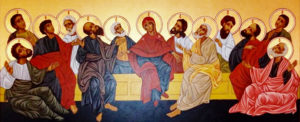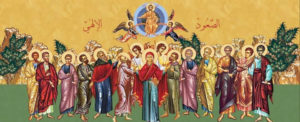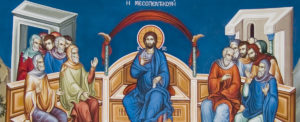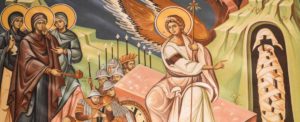The Feast of the Dormition of the Theotokos and Ever-Virgin Mary is celebrated on August 15 each year. The Feast commemorates the repose or “falling-asleep” of the Mother of Jesus Christ, our Lord. The Feast also commemorates the translation of her body into heaven.
The Holy Scriptures tell us that when our Lord was dying on the Cross, He saw His mother and His disciple John, and said to her, “Woman, behold your son!” and to John, “Behold your mother!” (John 19:25-27). The Virgin Mary had no other sons to care for her – Joseph’s sons were from his previous marriage and had no obligation to her – so from that hour, the Apostle took care of the Theotokos in his own home. Along with the biblical reference in Acts 1:14 that confirms that the Virgin Mary was with the Holy Apostles on the day of Pentecost, the tradition of the Church holds that she remained in the home of the Apostle John in Jerusalem, continuing a ministry in word and deed.
At the time of her death, the disciples of our Lord who were preaching throughout the world returned to Jerusalem to see the Theotokos. Except for the Apostle Thomas, all of them including the Apostle Paul were gathered together at her bedside. At the moment of her death, Jesus Christ himself descended and gathered her soul into heaven.
Miraculous was the life of the All-Pure Virgin, and wondrous was Her Repose, as Holy Church sings: “In Thee, O Queen, the God of all hath given thee as thy portion the things that are above nature. Just as in the Birth-Giving He did preserve Thine virginity, so also in the grave He did preserve Thy body from decay” (Canon 1, Ode 6, Troparion 1).
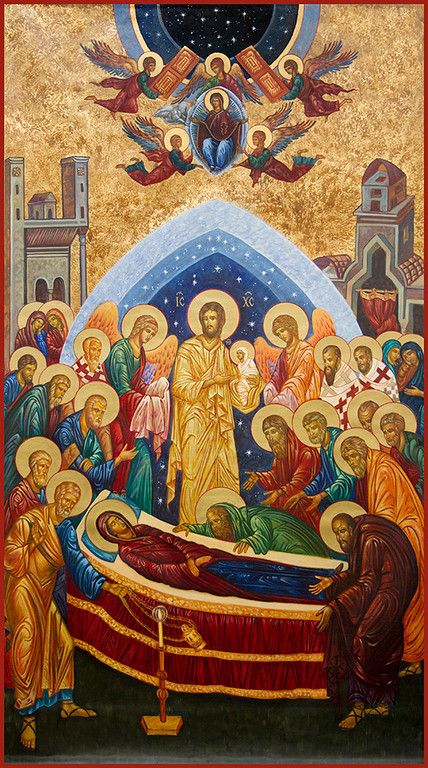 Kissing the all-pure body with reverence and in awe, the Disciples in turn were blessed by it and filled with grace and spiritual joy. Through the great glorification of the Most Holy Theotokos, the almighty power of God healed the sick, who with faith and love touched the holy bed.
Kissing the all-pure body with reverence and in awe, the Disciples in turn were blessed by it and filled with grace and spiritual joy. Through the great glorification of the Most Holy Theotokos, the almighty power of God healed the sick, who with faith and love touched the holy bed.
The body of the Theotokos was carried in procession and laid in a tomb near the Garden of Gethsemane. For three days they did not depart from the place of burial, praying and chanting Psalms. Through the wise providence of God, the Apostle Thomas was not present at the repose of the Mother of God. Arriving late on the third day at Gethsemane, he lay down at the tomb and with bitter tears asked that he might be permitted to look once more upon the Mother of God and bid her farewell. The Apostles out of compassion for him decided to open the grave and permit him the comfort of venerating the holy relics of the Ever-Virgin Mary. Having opened the grave, they found in it only the grave wrappings, and were thus convinced of the bodily ascent of the Most Holy Virgin Mary to Heaven.
On the evening of the same day, when the Apostles had gathered at a house to strengthen themselves with food, the Mother of God appeared to them and said: “Rejoice! I am with you all the days of your lives.” This so gladdened the Apostles and everyone with them, that they took a portion of the bread, set aside at the meal in memory of the Savior (“the Lord’s Portion”), and they exclaimed: “Most Holy Theotokos, save us!” (This marks the beginning of the rite of offering up the “Panagia” (“All-Holy”), a portion of bread in honor of the Mother of God, which is done at monasteries to the present day).
The sash of the Mother of God, and Her holy robe, preserved with reverence and distributed over the face of the earth in pieces, have worked miracles both in the past and at present. Her numerous icons everywhere pour forth signs and healings, and Her holy body, taken up to Heaven, bears witness to our own future life there. Her body was not left to the vicissitudes of the transitory world, but was incomparably exalted by its glorious ascent to Heaven.
The Feast of the Dormition of the Most Holy Theotokos is celebrated with special solemnity at Gethsemane, the place of Her burial. Nowhere else is there such sorrow of heart at the separation from the Mother of God, and nowhere else such joy, because of Her intercession for the world.
Hymns of the Feast
Troparion, Tone 1
In giving birth you preserved your virginity; in falling asleep you did not forsake the world, O Theotokos. You were translated to life, O Mother of Life, and by your prayers, you deliver our souls from death.Kontakion, Tone 2
Neither the tomb, nor death could hold the Theotokos, who is constant in prayer and our firm hope in her intercessions. For being the Mother of Life, she was translated to life by the One who dwelt in her ever-virgin womb.
From the second homily of Saint John of Damascus on the Dormition
And that all this is true is confirmed by the third book of the Euthymiac History, chapter 40, where we read, in so many words: “It was said above that Saint Pulcheria erected many churches for Christ in Constantinople. One of these is the church in Blachernae, built at the beginning of the reign of the divinely-appointed Emperor Marcian [who acceded to the throne August, 450]. When the two of them built a worthy house there for the all-glorious and all-holy Mother of God, the ever-virgin Mary, and adorned it with every sort of decoration, they hoped to find her holy body, which had been the dwelling-place of God. And summoning Juvenal, the Archbishop of Jerusalem, and those bishops from Palestine who were staying in the capital because of the synod then being held in Chalcedon [October, 451], they said to them: ‘We have heard that the first and most outstanding church of the all-holy Mother of God, the ever-virgin Mary, is in Jerusalem, in the place called Gethsemane, where her life-giving body was put in a coffin. We now wish to bring this relic here, to protect this royal city.’
“Juvenal answered, on behalf of them all: ‘There is nothing in the holy, inspired Scripture about the death of Mary, the holy Mother of God; but we know from ancient and wholly reliable tradition that at the time she so gloriously fell asleep, all the holy Apostles, who were traveling the world for the salvation of the peoples, were lifted up in a single instant of time and were gathered at Jerusalem; and as they stood by her, they saw a vision of angels, and heard the divine chanting of the higher powers. So it was that she gave her soul, in an ineffable way, into God’s hands, surrounded by the glory of God and all heaven. Her body, which had been God’s dwelling place, was brought for burial amidst the singing of the angels and the Apostles, and laid to rest in a coffin in Gethsemane; and the angelic dancing and singing continued without pause in that place for three days. But after three days, the song of the angels ceased; the Apostles were there, and since one of them – Thomas – had not been present [for her burial] and came at the end of three days, and wished to reverence that body which had housed God, they opened the coffin. And they could not find her body, which had been the object of such praise; all that they found were her burial wrappings. And being overcome by the ineffable fragrance that came out of the wrappings, they closed the coffin again. Amazed by this miraculous discovery, they could only draw a single conclusion: The one who had deigned to become flesh in her own person, and to take his humanity from her, the one who willed to be born in human flesh as God the Word, the Lord of glory, and who had preserved her virginity intact even after childbirth, now chose, after her departure from this world, to honor her pure and immaculate body with the gift of incorruptibility, and with a change of state even before the common, universal resurrection.
“’The excellent Apostle Timothy, the first bishop of Ephesus, was present there, with the [other] Apostles, and also Dionysius the Areopagite, as the great Dionysius himself tells us in his elaborate remarks about the blessed Hierotheos – who was also present then – which are addressed to Timothy. Dionysius writes: “Once we, as you know, and he and many of our holy brethren had come together, along with our inspired hierarchs, to see the body that our source of life; James, brother of God, was there, and Peter, the chief and senior leader of those who spoke of God. After we had seen it, all the hierarchs resolved to sing the praise, as each was able, of the infinitely powerful goodness of the divine strength.”’ [St. Dionysius, On the Divine Names 3.2; cf. Also the commentary of Maximus the Confessor (PG 4.236 C) which identifies the incident in the passage as that of the death and glorification of Mary.]
“When the imperial couple heard this, they asked the archbishop Juvenal to send them the holy coffin, properly sealed, with the funeral garments in it of the glorious, all-holy Mary, Mother of God. And when he had sent it, they placed it in the church of the holy Mother of God that had been built at Blachernae.”
From On the Dormition of Mary: Early Patristic Homilies. Daley, Brian E., trans.

